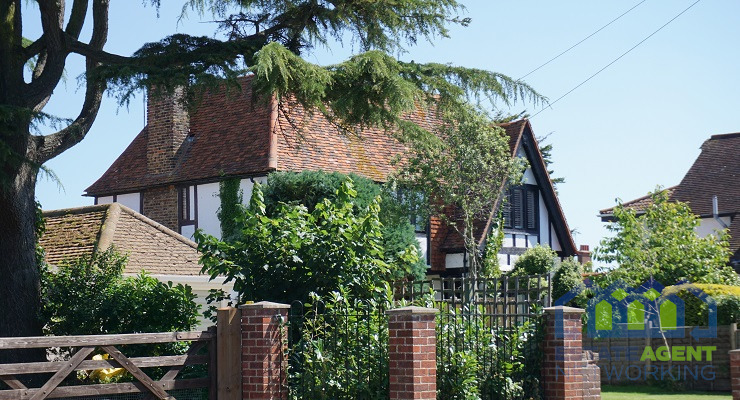Edinburgh beats the south coast as the silver homebuyer retirement hotspot
The latest research by estate agent comparison site, GetAgent.co.uk, has looked at where across the UK is home to the highest demand for retirement properties and where offers the largest number as a proportion of all homes for sale.
GetAgent.co.uk looked at the number of retirement homes for sales across major UK cities and which was home to the highest proportion of retirement property stock, as well as the highest demand for these properties based on the ratio of stock listed on the major property portals, to that which was already sold subject to contract.
Highest levels of retirement stock
The highest level of retirement property stock available as a proportion of all stock is currently found in Portsmouth, with 5.4% of properties listed in the city falling within the retirement category.
Bournemouth ranked second with 3.8% of all stock listed as retirement properties, closely followed by Oxford (3.4%), Bristol (3,3%) and Cambridge (3.1%). Sutton was the London borough home to the highest level of retirement stock in London at 5.9%, with Redbridge, Bexley and Bromley also home to 4% or more of the total stock listed for silver homebuyers.
Highest demand for retirement stock
While stock levels are one thing, GetAgent also looked at where the highest demand for this stock was across the UK based on the number of properties sold to those listed for sale.
Edinburgh topped the table as the most in-demand town for silver homebuyers with 57.8% of all retirement stock listed already under offer or sold subject to contract. Newport in Wales came second with a demand score of 55%, with Glasgow (46.8%), Manchester (43.8%) and Sheffield (41.5%) also ranking high.
In London, Haringey is the most in-demand borough for retirees with 66.7% of retirement stock already being snapped up. Southwark and Tower Hamlets also scored high with a demand score of 54.2% and 50% respectively.
Founder and CEO of GetAgent.co.uk, Colby Short, commented:
“We tend to focus on those taking that first step on the ladder but there is, of course, a whole other segment of buyers at the other end of the property life-cycle.
Although silver homebuyers account for a more marginal share of the market, it’s interesting to see where they are opting for when it comes to investing in their golden years and how this demand has shifted from the perhaps more traditional areas.
Previously, the trend was to move to the coast and while these areas are still home to some of the highest level of retirement properties as a result, it would seem that Edinburgh is now the most in-demand amongst buyers and in need of more retirement focussed developments.”
|
Rankings – most in-demand amongst buyers by city
|
|
|
City
|
Retirement Demand
|
|
Edinburgh
|
57.8%
|
|
Newport
|
55.0%
|
|
Glasgow
|
46.8%
|
|
Manchester
|
43.8%
|
|
Sheffield
|
41.5%
|
|
Nottingham
|
40.0%
|
|
Leeds
|
36.0%
|
|
Liverpool
|
33.9%
|
|
Oxford
|
33.3%
|
|
Cardiff
|
32.7%
|
|
Leicester
|
30.4%
|
|
Bournemouth
|
29.7%
|
|
Swansea
|
27.8%
|
|
Birmingham
|
27.5%
|
|
Cambridge
|
26.8%
|
|
Bristol
|
26.3%
|
|
Plymouth
|
26.3%
|
|
Southampton
|
26.3%
|
|
London
|
22.5%
|
|
Newcastle
|
21.1%
|
|
Portsmouth
|
17.8%
|
|
Aberdeen
|
12.5%
|
|
Belfast
|
0.0%
|
|
Rankings – most in-demand amongst buyers by London borough
|
|
|
Location / borough
|
Retirement Demand
|
|
Haringey
|
66.7%
|
|
Southwark
|
54.2%
|
|
Tower Hamlets
|
50.0%
|
|
Greenwich
|
39.6%
|
|
Westminster
|
38.5%
|
|
Richmond upon Thames
|
34.5%
|
|
Kingston upon Thames
|
33.3%
|
|
Kensington and Chelsea
|
33.3%
|
|
Enfield
|
31.1%
|
|
Hillingdon
|
30.4%
|
|
Hounslow
|
29.2%
|
|
Bexley
|
27.5%
|
|
Wandsworth
|
26.1%
|
|
Lewisham
|
25.8%
|
|
Havering
|
25.6%
|
|
Bromley
|
20.9%
|
|
Redbridge
|
20.7%
|
|
Croydon
|
20.5%
|
|
Merton
|
20.4%
|
|
Ealing
|
20.0%
|
|
Harrow
|
19.0%
|
|
Waltham Forest
|
18.3%
|
|
Hackney
|
18.2%
|
|
Barking and Dagenham
|
16.2%
|
|
Brent
|
16.2%
|
|
Sutton
|
12.9%
|
|
Barnet
|
11.8%
|
|
Islington
|
10.0%
|
|
Camden
|
8.3%
|
|
Newham
|
4.5%
|
|
Lambeth
|
2.9%
|
|
Hammersmith and Fulham
|
0.0%
|
|
City of London
|
0.0%
|
|
Retirement property as a % of total properties by city
|
|
|
City
|
Retirement as % of total
|
|
Portsmouth
|
5.4%
|
|
Bournemouth
|
3.8%
|
|
Oxford
|
3.4%
|
|
Bristol
|
3.3%
|
|
Cambridge
|
3.1%
|
|
Southampton
|
3.1%
|
|
Plymouth
|
2.8%
|
|
Birmingham
|
2.7%
|
|
Swansea
|
2.7%
|
|
Cardiff
|
2.6%
|
|
Edinburgh
|
1.8%
|
|
Newcastle
|
1.8%
|
|
Leeds
|
1.8%
|
|
Nottingham
|
1.7%
|
|
Leicester
|
1.6%
|
|
Glasgow
|
1.5%
|
|
Liverpool
|
1.4%
|
|
Aberdeen
|
1.3%
|
|
Sheffield
|
1.3%
|
|
Newport
|
1.2%
|
|
London
|
1.1%
|
|
Manchester
|
1.0%
|
|
Belfast
|
0.0%
|
|
Retirement property as a % of total properties by London borough
|
|
|
Location / borough
|
Retirement as % of total
|
|
Sutton
|
5.9%
|
|
Redbridge
|
5.8%
|
|
Bexley
|
4.8%
|
|
Bromley
|
4.0%
|
|
Harrow
|
3.6%
|
|
Waltham Forest
|
3.5%
|
|
Barnet
|
3.0%
|
|
Croydon
|
3.0%
|
|
Barking and Dagenham
|
2.7%
|
|
Brent
|
2.6%
|
|
Enfield
|
2.6%
|
|
Havering
|
2.4%
|
|
Merton
|
2.1%
|
|
Greenwich
|
1.9%
|
|
Kingston upon Thames
|
1.5%
|
|
Hillingdon
|
1.5%
|
|
Richmond upon Thames
|
1.1%
|
|
Ealing
|
1.1%
|
|
Lewisham
|
1.1%
|
|
Hounslow
|
0.9%
|
|
Newham
|
0.9%
|
|
Lambeth
|
0.9%
|
|
Southwark
|
0.7%
|
|
Wandsworth
|
0.5%
|
|
Hackney
|
0.5%
|
|
Camden
|
0.5%
|
|
Islington
|
0.4%
|
|
City of London
|
0.3%
|
|
Hammersmith and Fulham
|
0.3%
|
|
Westminster
|
0.3%
|
|
Kensington and Chelsea
|
0.2%
|
|
Haringey
|
0.1%
|
|
Tower Hamlets
|
0.1%
|









